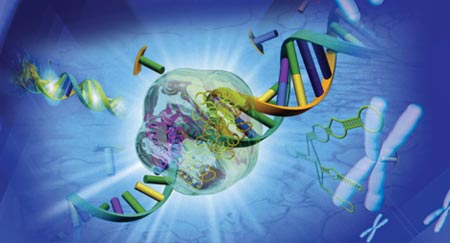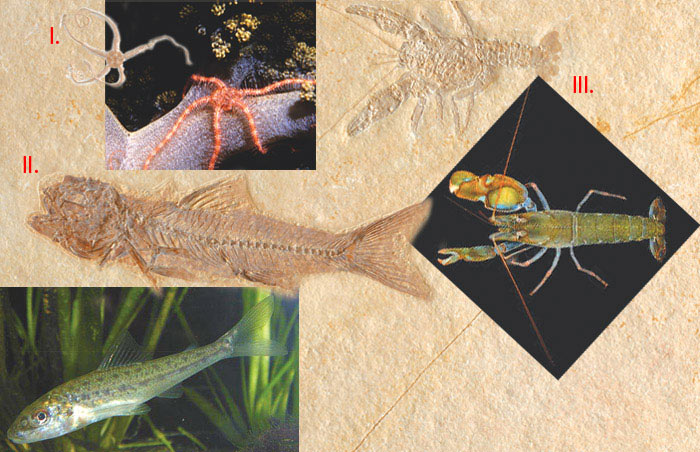Niles Eldredge
Those who came after Darwin made enormous efforts to detect in the fossil record examples of the slow and gradual evolution that he foresaw. Darwin had ascribed their absence to the "insufficiency of the fossil record." The fossil record—which, in fact, provided a broad range of specimens even in his own day and shows the existence of all complex life forms as early as the Cambrian Explosion—continued to be the subject of research by evolutionists hoping to discover a miracle. Their objective was to prove Darwin correct, to demonstrate that the fossil record in his time truly was insufficient, and to find examples of intermediate forms, evidence that living things did undergo evolution.
Yet the fossil record constantly produced results at variance with Darwin's expectations. Practically the entire globe was scoured, and the new fossils excavated were no longer "insufficient." Darwin had been wrong when he said that he believed that those who came after him would eventually find the intermediate forms that he expected. The fossil record produced not one single intermediate-form specimen. Instead, it revealed the fact that countless living things had undergone no evolution at all, had remained unchanged for many millions of years, together with all their many complex structures. The fossil record refuted Darwin. The lack of intermediate forms and the fact of stasis very definitely constituted no evidence for gradual evolution.
Some evolutionists clearly saw and admitted that Darwin's model of gradual evolution was untenable in the face of the reality of stasis. They then proposed that evolution "operated in a different way." In 1970, the Harvard University paleontologist Stephen Jay Gould and Niles Eldredge of the American Museum of Natural History developed an alternative theory, known as "punctuated evolution," which they published in 1972. Their sole aim was to account for the stasis phenomenon.

FAKE ILLUSTRATION
"Intermediate forms," which allegedly bore the features of two different species, never existed at any time.
In fact, this theory was an adaptation of the "Hopeful Monster" theory put forward in the 1930s by the European paleontologist Otto Schindewolf. He had suggested that living things evolved as the result of sudden, dramatic mutations rather than the gradual accumulation of small ones. In citing a hypothetical example of his theory, Schindewolf suggested that the first bird in history had emerged from a reptile egg, through a "gross mutation," in other words, an enormous, though random change in its genetic structure.28According to that same theory, some terrestrial mammals might suddenly have turned into whales through a sudden and comprehensive alteration.
These claims violate all known laws of genetics, biophysics and biochemistry, and were no more scientific than the fairy tale about a frog turning into a handsome prince. Still, this "Hopeful Monster" theory of Schindewolf's was adopted and defended in the 1940s by the University of California, Berkeley geneticist Richard Goldschmidt. But the theory was so inconsistent that it was soon abandoned.
The impetus that obliged Gould and Eldredge to take up this theory again was, as we have already seen, the lack of any "intermediate form" in the fossil record. Both the "stasis" and "sudden appearance" in the record were so obvious that these two were forced to reconsider the "Hopeful Monster" theory in order to account for this state of affairs. Gould's well-known article "The Return of Hopeful Monsters" was an expression of this forced about-turn.29
 Niles Eldredge Stephen Jay Gould |
Naturally, Eldredge and Gould did not repeat Schindewolf's theory word for word. In order to give it a more "scientific" nature, they sought to develop some kind of mechanism for the "sudden evolutionary leap" they proposed. (The interesting term "punctuated equilibrium" which they gave to their theory was one expression of this scientific endeavor.) Gould and Eldredge's theory was adopted and fleshed out by some other paleontologists in the years that followed. However, the punctuated theory of evolution was at least as marred with inconsistencies and invalid logic as Darwin's original gradual theory of evolution.
Proponents of gradual evolution ignored stasis. But stasis is constantly seen in the fossil record, proving that living things remained unchanged over millions of years. The only difference between Gould and Eldredge and other Darwinists is that the former two realized that the stasis in the fossil record was an incontrovertible fact that could no longer be left unanswered. Rather than admit the fact of Creation revealed by the fossil record, they felt themselves obliged to develop a new concept of evolution.
Stephen Jay Gould said this on the subject:
But how can imperfection possibly explain away stasis (the equilibrium of punctuated equilibrium)? Abrupt appearance may record an absences of information, but *stasis is data*. Eldredge and I became so frustrated by the failure of many colleagues to grasp this evident point—-though a quarter century of subsequent debate has finally propelled our claim to general acceptance (while much else about punctuated equilibrium remains controversial)—that we urged the incorporation of this little phrase as a mantra or motto. Say it ten times before breakfast every day for a week, and the argument will surely seep in by osmosis: "stasis is data: stasis is data..." 30
Gould, Eldredge and other advocates of punctuated evolution fiercely criticized the proponents of gradual evolution for failing to see the reality of stasis. But in fact, what they were doing was no different from the actions of other Darwinists. Since the fossil record had failed to produce the results they expected, they changed the form of so-called evolution and constructed it in a very detailed manner. The main reason for their anger toward, and intense criticism of, the adherents of gradual evolution was that as long as their professional colleagues failed to accept the stasis in the fossil record, they would cause the theory to lose all credibility in the public eye. For that reason, they attempted to give the impression that they had now "discovered the truth" in the face of the clear facts revealed by the fossil record.
The fact is, however, that the punctuated evolution model is at least as groundless, devoid of evidence, and ultimately discredited as the gradual evolution theory.
Gould's admissions regarding "the mistaken perspective in the past" are criticisms aimed at the supporters of gradual evolution:
We have long known about stasis and abrupt appearance, but have chosen to fob it off upon an imperfect fossil record.31
As Niles Eldredge describes it, the supporters of gradual evolution ignored one very important fact:
Paleontologists ever since Darwin have been searching (largely in vain) for the sequences of insensibly graded series of fossils that would stand as examples of the sort of wholesale transformation of species that Darwin envisioned as the natural product of the evolutionary process. Few saw any reason to demur—though it is a startling fact that . . . most species remain recognizably themselves, virtually unchanged throughout their occurrence in geological sediments of various ages.32

This 120-million-year-old fossil tortoise is proof that tortoises are not descended from other living things, never underwent any intermediate stages, and have maintained exactly the same structure for millions of years.
Darwin's prediction of rampant, albeit gradual, change affecting all lineages through time is refuted. The record is there, and the record speaks for tremendous anatomical conservation. Change in the manner Darwin expected is just not found in the fossil record.33
Elsewhere, Stephen Jay Gould described how stasis, evidence of non-evolution, was ignored by the adherents of evolution:
Stasis, or nonchange, of most fossil species during their lengthy geological lifespans was tacitly acknowledged by all paleontologists, but almost never studied explicitly because prevailing theory treated stasis as uninteresting nonevidence for nonevolution. . . . The overwhelming prevalence of stasis became an embarrassing feature of the fossil record, best left ignored as a manifestation of nothing (that is, nonevolution).34
All of Gould and Eldredge's efforts were to adapt the theoretical concept of evolution to the actual fossil record. For that reason they suggested that stasis itself was the most important proof of their evolutionary claims. In some way, they viewed the unchanging nature of the fossil record as evidence for change! Since they could not reconcile the fossil record with the theory of evolution, they adapted the theory to the record. This was the mindset that launched the punctuated model of evolution.
In an article in New Scientist, Tom S. Kemp, curator of the Oxford University museum's zoological collections, described how findings had been turned into evidence for the theory of evolution, just as in the case of punctuated evolution:
In other words, when the assumed evolutionary processes did not match the pattern of fossils that they were supposed to have generated, the pattern was judged to be ‘wrong.' A circular argument arises: interpret the fossil record in terms of a particular theory of evolution, inspect the interpretation, and note that it confirms the theory. Well, it would, wouldn't it? 35
According to the proponents of the punctuated model of evolution, stasis in the fossil record represented the "equilibrium" in the theory defined as punctuated equilibrium. The theory maintains that under environmental pressures, a species can have evolved in as short a space of time as only a few thousand years. It then entered a period of stasis and remained unchanged for millions of years.
Therefore, proponents believed that this claim could account for the stasis in a large proportion of living things. In this way, they thought they had covered up the challenge that the fossil record poses to evolution. But this was a grave deception.

In its present state, the punctuated theory of evolution explains living populations that exhibit no change over very long periods of time as having remained in a kind of "equilibrium." According to this claim, evolutionary changes take place in very narrow populations and at very short intervals that interrupt—or in other words, "punctuate" the equilibrium. Since the population is such a narrow one, natural selection quickly favors large mutations, and the emergence of a new species is thus made possible.
According to this theory, a reptile species, for example, can remain unchanged for millions of years. However, one small group of reptiles that split away from this species in some way is subjected to a series of intense mutations, for some reason that is not explained. These mutations endow those individuals with some advantage (and there is no instance of a beneficial mutation). They are quickly selected within this narrow group. The group of reptiles evolves quickly, and may even turn into mammals. Since this entire process is so very rapid and takes place with a relatively small number of creatures within a narrow time frame, few if any fossil traces are left behind.
As close inspection reveals, this theory was proposed as an answer to the question of "How can an evolutionary process happen so fast as to leave no fossil traces behind?" In reply, the theory makes two fundamental assumptions:
1. The assumption that macro-mutations—in other words, wide-ranging mutations that cause major changes in living things' genetic information—bestow an advantage and also produce new genetic information.
2. The assumption that small animal populations have a genetic advantage.
However, both are at odds with the scientific facts.

As you have just seen, the punctuated model of evolution hypothesizes that the mutations leading to speciation take place on a very large scale or that some individual species are exposed to a succession of serial mutations. However, that assumption contradicts all the observational data from genetic science.
R. A. Fisher, one of the century's best-known geneticists, established a rule, based on experiment and observation, that invalidates this hypothesis. In his book The Genetical Theory of Natural Selection, Fisher reports that any mutation's ability to survive in a population is inversely proportional to its effect on the phenotype.36To put it another way, the greater a mutation is, the lower will be its chances of remaining permanent in a community.
The reason for this is not hard to see. Mutations represent random changes in a living thing's genetic data. They never have the effect of improving that genetic information. On the contrary, mutated individuals always suffer serious diseases and disabilities. Therefore, the more any individual is affected by mutation, the lower its chances of survival.
The Harvard University evolutionary biologist Ernst Mayr, one of Darwinism's most passionate advocates, makes the following comment:
The occurrence of genetic monstrosities by mutation . . . is well substantiated, but they are such evident freaks that these monsters can be designated only as "hopeless." They are so utterly unbalanced that they would not have the slightest chance of escaping elimination through stabilizing selection . . . the more drastically a mutation affects the phenotype, the more likely it is to reduce fitness. To believe that such a drastic mutation would produce a viable new type, capable of occupying a new adaptive zone, is equivalent to believing in miracles . . . The finding of a suitable mate for the "hopeless monster" and the establishment of reproductive isolation from the normal members of the parental population seem to me insurmountable difficulties.37

Obviously, mutations do not give rise to evolutionary development—which poses an insurmountable obstacle for the punctuated theory of evolution. Since mutation is destructive, the living undergoing macro-mutations that the proponents of evolution propose will suffer "macro"-destructive effects. Some evolutionists put their trust in mutations occurring in the regulatory genes in DNA. But the destructive effect that applies in regard to other mutations also applies here. The problem is that mutation is a random change, and any random change in any structure as complex as genetic information will have damaging consequences.
In their book The Natural Limits to Genetic Change, geneticist Lane Lester and population geneticist Raymond Bohlin describe the mutation dilemma in question:
The overall factor that has come up again and again is that mutation remains the ultimate source of all genetic variation in any evolutionary model. Being unsatisfied with the prospects of accumulating small point mutations, many are turning to macromutations to explain the origin of evolutionary novelties. Goldschmidt's hopeful monsters have indeed returned. However, though macromutations of many varieties produce drastic changes, the vast majority will be incapable of survival, let alone show the marks of increasing complexity. If structural gene mutations are inadequate because of their inability to produce significant enough changes, then regulatory and developmental mutations appear even less useful because of the greater likelihood of nonadaptive or even destructive consequences . . . But one thing seems certain: at present, the thesis that mutations, whether great or small, are capable of producing limitless biological change is more an article of faith than fact.38
Observation and experiment show that mutations may alter, but do not improve on, genetic information and that they do damage living things. It is obviously inconsistent for the proponents of punctuated evolution to expect any "success" from them.

The second concept that proponents of punctuated evolution stress is that of "narrow populations." They state that a new species forms only in communities containing very few numbers of a plant or animal species. According to this claim, large populations of animals exhibit no evolutionary development and can maintain their stasis. However, if some small groups leave these populations, they become isolated (generally assumed because of geographical causes) and can reproduce only amongst themselves. It is claimed that macro-mutations affect these small groups because they reproduce only among themselves, and so rapid "speciation" thus takes place.
Why do the proponents of punctuated evolution insist on the concept of narrow populations? The answer is obvious: Their objective is to "explain" the lack of intermediate forms in the fossil record. That is why their accounts insist that "Evolutionary changes took place in narrow populations and very rapidly, for which reason insufficient traces have been left in the fossil record."
In fact, however, recent scientific experiments and observations have revealed that in genetic terms, narrow populations are a disadvantage for evolution. Far from developing in such a way as to give rise to robust new species, narrow populations actually produce severe genetic defects. The reason is that in small populations, individuals continually interbreed, reproducing within a narrow genetic pool. For that reason, normally "heterozygotic" individuals become increasingly "homozygotic." Their normally recessive defective genes become dominant, and genetic defects and diseases increasingly emerge within the population.39
In order to investigate this topic, chickens were observed for 35 years. These observations established that chickens kept in a narrow population became increasingly weaker in genetic terms. Egg production fell from 100% to 80%; reproduction rates from 93% to 74%. But through conscious human intervention—with chickens being brought in from other populations—this genetic contraction was reversed, and the basic chicken population began moving back in the direction of normality.40

This and similar findings clearly show that there is no scientific validity to the claim that narrow populations are the source of evolutionary development, behind which adherents of punctuated evolution find shelter. James W. Valentine and Douglas H. Erwin have stated the impossibility of new species forming by way of punctuated evolutionary mechanisms:
The required rapidity of the change implies either a few large steps or many and exceedingly rapid smaller ones. Large steps are tantamount to saltations and raise the problems of fitness barriers; small steps must be numerous and entail the problems discussed under microevolution. The periods of stasis raise the possibility that the lineage would enter the fossil record, and we reiterate that we can identify none of the postulated intermediate forms. Finally, the large numbers of species that must be generated so as to form a pool from which the successful lineage is selected are nowhere to be found. We conclude that the probability that species selection is a general solution to the origin of higher taxa is not great, and that neither of the contending theories of evolutionary change at the species level, phyletic gradualism or punctuated equilibrium, seem applicable to the origin of new body plans.41
Today, the fictitious mechanism of punctuated equilibrium has been totally discredited in scientific terms. It has been proved that living things cannot evolve through the methods in question. As Jeffrey Levinton from the State University of New York has stated, there can be no way to test the theory of species formation in question if it cannot be seen clearly in the fossil record.
On that basis, Levinton concluded that "the totality of the evidence makes it a theory not worth following up." 42
This is of course true. The claim constituting the foundation of the theory has been refuted scientifically. But the important fact is that the fossil record has provided no evidence for punctuated equilibrium; on the contrary, it has demolished it. Millions of fossils in the record have been in a state of "equilibrium" that the evolutionists claim to have lasted for millions of years, as punctuated equilibrium suggests. Yet for some reason, there is absolutely no trace of the intervening evolution that—again according to the theory—should have lasted for thousands of years, at least. The fossil record provides not one single example of the countless living things expected to have undergone evolution. Nor is there a single piece of evidence to show how punctuated equilibrium might work. As the result of their desperate situation, evolutionists try to take one of the greatest proofs of the fact of Creation and use it as a basis for evolution. This clearly demonstrates the terrible position they are in!
How did such an inconsistent theory ever become so popular? In fact, almost all the proponents of punctuated equilibrium are paleontologists, who clearly see how the fossil record refutes Darwinian theory.

I.A 150-million-year-old fossil brittlestar showing that these echinoderms have not changed at all for millions of years.
II.There is no difference between this 50-million-year-old fossil trout-perches and specimens living today.
III:There is no difference between lobsters living today and this 208- to 146-million-year-old fossil.
This is why they are literally in a state of panic and trying to keep their theory viable at any cost.
On the other hand, geneticists, zoologists and anatomists perceive that no mechanism in nature could give rise to "punctuations," for which reason they insist on supporting the gradual Darwinist theory of evolution. The Oxford University zoologist Richard Dawkins strongly criticizes adherents of the punctuated model of evolution and accuses them of destroying the credibility of the theory as a whole.This inconclusive dialogue between the two sides is actually evidence of the scientific crisis into which the theory of evolution has fallen. What we have is a myth that cannot be reconciled with any experimental, observational or paleontological findings. All evolutionist theoreticians look for grounds to support this myth, depending on their own field of specialization, but find themselves in conflict with findings from other branches of science. Attempts are sometimes made to gloss over this confusion by means of superficial comments such as "Science advances through such academic debates." Yet the problem is that these debates are not mental gymnastics performed for the sake of coming up with any true scientific theory, but are dogmatic conjecture intended to support a false theory. The fact that evolutionary theoreticians inadvertently reveal is that the fossil record cannot be reconciled with the concept of evolution in any way. And stasis, one of the most important elements in the fossil record, is clearly visible. Gould expresses this in these terms:
. . . stasis, inevitably read as absence of evolution, had always been treated as a non-subject. How odd though to define the most common of all palaeontological phenomena as beyond interest or notice!43
By now, all Darwinists have been forced to admit the fact of stasis in the fossil record, which they are still reluctant to see, deliberately pushing into the background and even refusing to accept as data. The lack of any documentation of fossils undergoing evolution—in other words, the absence of any intermediate forms—has done away with all speculation regarding stasis and clearly reveals this as one of the most significant proofs of the fact of Creation. Punctuated equilibrium has been totally discredited, both by the very mechanisms it proposes and by the fossil record, which it seeks to put forward as evidence.
28 Stephen M. Stanley, Macroevolution: Pattern and Process, San Francisco: W. H. Freeman and Co. 1979, s. 35, 159.
29 Gould, S. J. 1980. "Return of the Hopeful Monster"; The Panda's Thumb, New York, New York: W. W. Norton Co., s. 186-193.
30 http://www.blavatsky.net/features/newsletters/2005/fossil_record.htm
31 Stephen J. Gould, "The Paradox of the First Tier: An Agenda for Paleobiology", Paleobiology, 1985, s. 7 - http://www.genesispark.org/genpark/after/after.htm
32 Niles Eldredge, "Progress in Evolution?", New Scientist, vol. 110, 1986, s. 55 - http://www.genesispark.org/genpark/after/after.htm
33 N. Eldredge and I. Tattersall, The Myths of Human Evolution, 1982, s. 48
34 Stephen J. Gould, "Cordelia's Dilemma", Natural History, 1993, s. 15
35 Kemp, Tom S., "A Fresh Look at the Fossil Record", New Scientist, vol. 108, 1985, s. 66-67
36 R. A. Fisher, The Genetical Theory of Natural Selection, Oxford, Oxford Univesity Press, 1930
37 Ernst Mayr, Populations, Species, and Evolution, Cambridge, Mass: Belknap Press, 1970, s. 235
38 Lane Lester, Raymond Bohlin, The Natural Limits to Biological Change, Probe Books, Dallas, 1989, s. 141
39 M. E. Soulé and L. S. Mills, "Enhanced: No Need To Isolate Genetics", Science, 1998, vol. 282, s. 165
40 R. L. Westemeier, J. D. Brawn, J. D. Brawn, S. A. Simpson, T. L. Esker, R. W. Jansen, J. W. Walk, E. L. Kershner, J. L. Bouzat and K. N. Paige, "Tracking The Long-term Decline and Recovery of An Isolated Population", Science, 1998, vol. 282, s. 1695.
41 Valentine and Erwin, 1985, s. 96 - http://www.arn.org/docs/abstasis.htm
42 http://www.dhushara.com/book/evol/evop.htm
43 Gould. S. J. and Eldredge. N., 1993. "Punctuated Equilibrium Comes of Age", Nature, 366, s. 223, - http://www.answersingenesis.org/tj/v8/i2/punct.asp